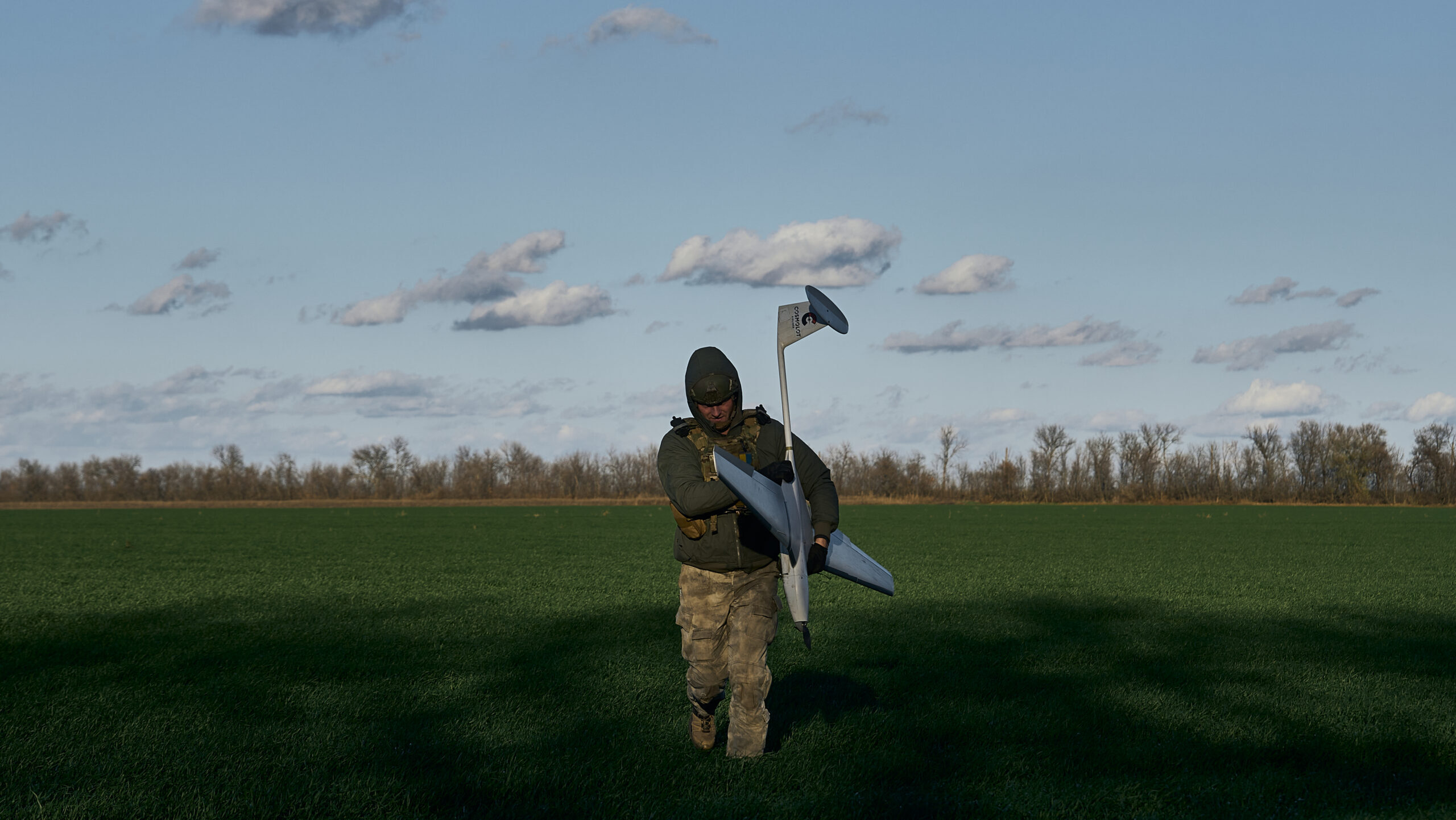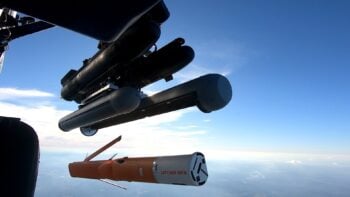
After that date, image will need to be licensed from the website.) Ukrainian military operate a Punisher drone, a small fixed-wing reusable aircraft used by frontline infantry to strike military targets, on November 7, 2023 near Vuhledar, Ukraine. (Photo by Kostya Liberov/ Libkos via Getty Images)
AOC 2023 — The visible front line has hardly moved in months, but above the trenches and minefields dividing Ukraine, an invisible battle rages back and forth in the airwaves.
Both sides are constantly updating their drones and their anti-drone tactics, which depend above all else on the radio connections used to control the unmanned aircraft and to relay the vital intelligence they collect to commanders, artillery batteries and missile launchers. Both sides have invested heavily in radio-frequency jamming and deception — electronic warfare — to misdirect missiles and bring down drones, with Ukraine alone losing an estimated five to ten thousand every month. And this cat-and-mouse game moves so rapidly, Ukrainian and NATO experts said at the Association of Old Crows’ annual electronic warfare conference, that tech needs to be upgraded about every eight weeks.
RELATED: Amid Ukraine and Israel conflicts, Pentagon acquisition chief sees counter-drone ‘crisis’
“The electromagnetic environment in the eastern Donbas is the most complex in the world,” said Air Commodore Blythe Crawford, commandant of the Royal Air Force’s Air & Space Warfare Centre (ASWC). “If you’re turning out version 1.1, you’ve got eight weeks before you churn out version 1.2.”
A Ukrainian reserve officer and tech entrepreneur, Capt. Iaroslav Kalinin, made the same point more bluntly as he whipped through a presentation of different drone types the two sides had fielded one after another. “Whatever I show you becomes obsolete in the next two months,” Kalinin told the AOC conference.
Big, purpose-built military drones like the Turkish Bayraktar TB2 that were stars at the start of the war have given way to hobbyist mini-drones and, increasingly, racing drones controlled by operators using VR goggles to get a drone’s-eye-view — what’s called “First Person View” (FPV) control.
Both sides have turned the agile, speedy FPV drones into ad hoc smart bombs and, Kalinin said, the Ukrainians are now even using them as interceptors to bring down larger Russian drones. Meanwhile, operators are constantly adjusting control frequencies to bypass jamming, changing how they hide from retaliatory strikes — which prioritize drone operators — and extending range by such tricks as relaying the control signal through a secondary drone.
“The side that prevails will be the side that innovates the quickest,” said Crawford.
But which side is that? While the Russians have a well-earned reputation for rigidity, “they’re also learning,” said Maj. Gen. Borys Kremenetskyi, a Ukrainian air force officer currently serving as defense attaché to the US. “They’re adapting [their] tactics.”
When the war began, Kremenetskyi said, Ukraine was fighting “the big Soviet Army”: long columns of tanks, troop carriers and trucks surged into Ukrainian territory — and often got stuck when resistance proved greater than planned, like the infamous 40-mile “traffic jam” north of Kyiv. As the war ground on, Cold War-era mechanized echelons increasingly gave way to human wave attacks of poorly supported foot troops, straight out of the darkest days of the “Great Patriotic War” against the Nazis. But the Russians also launched relentless missile and drone attacks against Ukrainian cities, and, Kremenetskyi said, there they were careful to vary their flight paths from strike to strike and use recon drones to scout for weak points in Ukraine’s hard-pressed air defenses.
In the cyber/electronic warfare domain, the Russians began the war with a knockout blow against the ViaSat communications network on which Ukrainian troops depended, only for Elon Musk’s Starlink to save the day. Starlink has proved remarkably resilient against hacking and jamming. But, Kremenetskyi warned, the Russians learned to look for areas of “mass internet access” and other signs that Starlink terminals were online, then target them.
Nevertheless, Kremenetskyi expressed confidence that Ukraine’s more Westernized society and military could adapt faster than the authoritarian Russians. “Innovation is one of our advantages,” he said. In particular, since the devastating losses in Crimea and eastern Donbass during the Russian invasion of 2014, Ukraine has reformed its armed forces to allow more initiative among junior frontline troops — the soldiers are actually storming trenches and reconfiguring drones.
“We transferred a lot of authorities to junior officers,” the general said. “We created a very powerful non-commissioned officers corps, which allows us to make decisions in trenches. Our soldiers do not wait for a general somewhere in headquarters. …They can use their own initiative on the battlefield. That is one of our advantages.”
Those tactical and technical reforms made a particular difference in electronic warfare: Russian jamming paralyzed Ukrainian command systems in 2014, but failed to bring them down in 2022.
“The biggest boogeyman in the world was Russian EW,” said Jeff Fischer, a former US Air Force electronic warfare officer. “[People said] ‘they’re light years ahead of us.’ No, they’re not.”
Sure, he told the AOC conference, the technical specifications of Russian systems were impressive, and specimens acquired by intelligence agencies performed magnificently in field tests on US ranges — where they were operated by US-trained crews with top-notch technical support. In the mud and chaos of actual conflict, however, with patchy maintenance and tired, under-trained crews, their combat performance was much worse.
That said, Fischer warned, the brutal natural selection of ongoing combat is forcing even the Russians to get better. “I will say, even though Russia wasn’t great at the beginning, fighting is training, so they might be losing guys but they’re learning,” he said. “Russia’s getting actually relatively good, only because they’re being forced to do so.”
What Russia lacks in bottom-up initiative, it might be able to make up its ability to ruthlessly mobilize all available resources to serve the autocrat’s objectives, argued Crawford.
“Rather than being a question of, ‘are we ahead or are we behind’ … it is a battle of innovation models,” he said. “You have Ukraine, which is slightly more Western in its approach, a bottom-up innovation model … versus a top-down autocratic model … where they have mobilized the nation’s industrial base to support that top-down innovation.”
As the war grinds on and Western resolve wavers, it’s hard to say whether the free world or the autocrats will prevail in the end.


